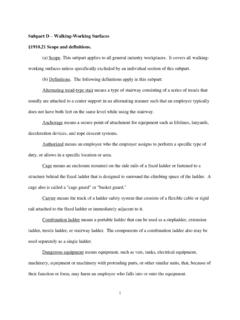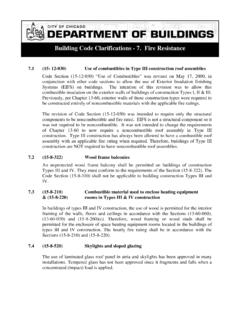Transcription of Harpur Hill, Buxton, Derbyshire, SK17 9JN
1 Crown copyright (2005) Harpur Hill, Buxton, Derbyshire, SK17 9JN Falls on Stairways Literature Review Report Number HSL/2005/10 Project Leader: Anita Scott Author(s): Anita Scott Science Group: Human Factors 1 PRIVACY MARKING: Available to the public (D) HSL report approval: Dr Steve Thorpe Date of issue: 28/04/05 Job number: JS2004191 Registry file: PED ST 2004 22824 Electronic filename: H:\Support\JS2004191 (Stairs Lit Review)\Documents\Final 2 CONTENTS 1 Introduction.
2 5 2 Background information .. 6 3 Existing Literature concerning stair falls .. 11 4 Reliability and Quality of existing information .. 13 5 Gaps in the literature and future 14 6 Causes of stairway 7 Reducing the occurrence of stairway falls .. 22 8 References .. 26 9 28 3 EXECUTIVE SUMMARY The primary aim of this piece of work was to provide an overview of the literature relating to falls on stairways. Falls from height is currently a Priority Programme for the Health and Safety Executive. Analysis of the RIDDOR statistics between 1996/97 and 2001/02 showed stairs to be the most common agent in low fall accidents (below two metres).
3 Analysis of the 2001/02 statistics showed the number of stair incidents to have decreased, however, there remained 500 low falls involving stairs, making stairs the second most common agent, behind ladders in this year. The objectives for this piece of work were as follows: Identify and analyse existing information and evidence of stairway falls Evaluate the quality, reliability and relevance of existing information and data Identify information and data gaps Provide an analysis of the possible causes of stair fall accidents including their relative importance Provide an analysis of the possible control measures that can be adopted by employers and their potential effectiveness Make recommendations for potential interventions by enforcing authorities, intermediaries and industry groups The scenario of falling down stairs was summed up quite poetically by Templer (1978, cited in Hemenway, 1994).
4 To fall down stairs is not only to fall off a cliff, but to fall on rocks below, for the nosings of steps presents a succession of sharp edges. Most stair accidents occur in domestic settings. This means that there is less information available to persons wishing to consider and reduce injuries from falling on stairs in the workplace. Industries that experience relatively high numbers of falls in the UK are the service, manufacturing and construction industries. The building regulations have controlled stairway design since 1944, however, they are not retrospective. As a result, there are many buildings in existence which do not meet the current required standards. Building regulations control aspects such as handrail and balustrade heights; step widths, goings and risers, and the step materials and lighting requirements for stairs.
5 Existing literature for stairway falls is based mainly on information derived from accident reports, casualty reports, coroners reports and compensation reports. A small proportion of these studies relate to falls in the workplace. Videotape has been used to analyse stair fall incidents, a relatively novel approach to the stair fall topic. The laboratory setting has also been the focus for studies to determine the step dimensions that maximise safety for pedestrians. In terms of the quality of existing information relating to stairway falls, the majority of the evidence presented is based on accident records. Detail is often lacking in such records and researchers in the field acknowledge this shortfall. There is a need for a thorough and structured method for investigating stairway accidents, which as a consequence will yield more detailed information for research purposes.
6 There are gaps to be filled in the research relating to stair falls. There has been relatively little research carried out relating to falls in the workplace, with most information relating to falls in the domestic setting. The use of videotape for assessing falls in real time is an avenue of research that could be explored further. Criticism in the past has been directed towards studies 4 set in the laboratory because the environment does not adequately simulate the conditions experienced during actual stair falls. Avenues for future research may include: Interrogation of industry-specific accident data to allow specific interventions to be developed instead of suggesting general and broad-based interventions.
7 The use of video to assess pedestrian traffic control measures (such as keep left signs and painted lines to separate up and down traffic). The development of a checklist for the investigation of stairway accidents, to enable more thorough and detailed accident investigations to be carried out. A survey to assess the prevalence of inconsistency in stairway dimensions. The effects of riser height on fatigue The effect of various flooring surfaces on the likelihood of slipping when using stairs. The monitoring of the slip resistant properties of stair nosings with use. The effect of different styles of footwear (for example, heeled versus non-heeled) on the likelihood of slipping when using stairs Stairway falls are usually caused by a combination of different factors.
8 Falls may be influenced by stair design, stair maintenance, the wider environment, the characteristics of the stair user (age, gender, physical fitness etc) or their behaviour. There is no evidence to suggest that one single factor is more important than any other. Control measures exist that may be used by employers to reduce stair fall occurrence. Regular housekeeping, maintenance and inspection are key to reducing the likelihood of stair falls. Features such as handrails, colour-contrasting anti-slip nosings and adequate lighting will improve the stairway environment. It has been suggested that controls to reduce the severity of injuries may be an avenue for exploration. Features such as carpet underlay may reduce the likelihood of bone fracture, particularly in the elderly.
9 For control measures to be applied at a more global level, it is believed that changes to the building regulations, in particular to increase stair goings, will be an effective intervention. Awareness campaigns to implement behavioural changes for stair behaviour is an avenue which deserves further exploration. Lessons can be learnt from private companies who have successfully implemented behavioural changes relating to stair use in their employees. 5 1 INTRODUCTION This piece of work was carried out at the request of Mr Ben Keene (HSE), of the Falls From Height priority programme.
10 The primary aim of the work was to provide an overview of the literature relating to stairway falls. Analysis of RIDDOR data between 1996/97 and 2000/01 showed stairs to be the most common agent involved in low fall accidents (below two metres). The number of stair falls has since fallen, but in 2001/02 there were still 500 low falls involving stairs, making stairs the second most significant agent after ladders. The objectives for this piece of work were as follows: Identify and analyse existing information and evidence of stairway falls. Evaluate the quality, reliability and relevance of existing information and data. Identify information and data gaps. Provide an analysis of the possible causes of stair fall accidents including their relative importance.













